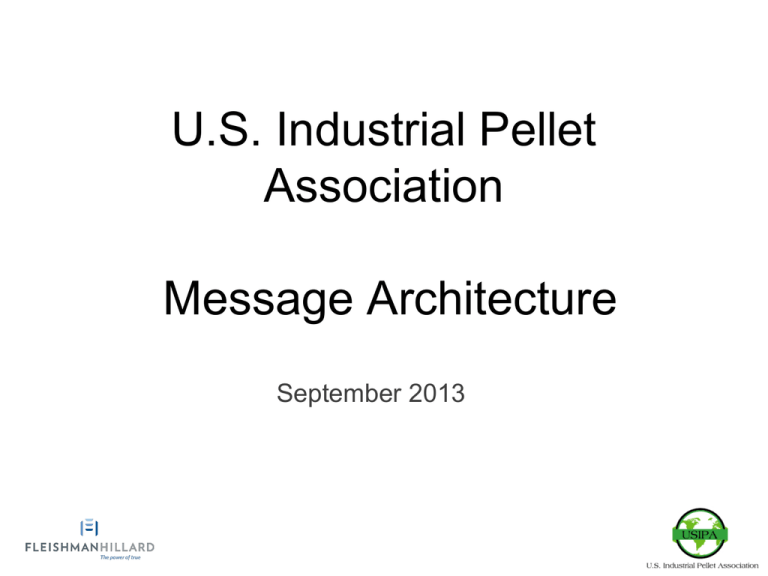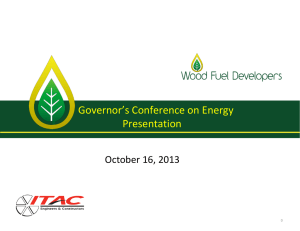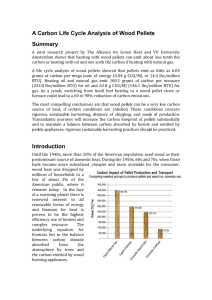USIPA Powerpoint Presentation
advertisement

U.S. Industrial Pellet Association Message Architecture September 2013 Executive Synopsis The following is the message architecture for USIPA member companies to use as the foundation for communicating to external audiences (media, regulators, policymakers) in Europe and the United States. The document is designed to ensure that USIPA representatives communicate a consistent message to all audiences. The message architecture is adaptable. Page 2 USIPA Message Architecture Top-line Message – What it offers Industrial wood pellets from the United States are an essential component of Europe’s power mix and provide an abundant, sustainable and carbon beneficial energy source that provides reliable baseload power to Europe. Pillar: Carbon Beneficial Pillar: Energy Mix Pillar: Sustainable Supply Industrial wood pellets are carbon beneficial when compared to fossil fuels. Industrial wood pellets are a vital part of the energy mix. Sustainability is an integral part of the U.S. industrial wood pellet industry. Proof Points and Examples Sub-Message: Carbon Beneficial Main Message • Wood pellets are carbon beneficial when compared to fossil fuels. Sub-messages • • • • • • • Sustainably managed industrial wood pellets are carbon beneficial. Biogenic carbon emissions are fundamentally different from fossil carbon emissions because they represent carbon that was recently pulled from the atmosphere through photosynthesis. Fossil fuel emissions represent carbon that is removed from permanent storage in the earth and added as new carbon into the atmosphere. Fossil carbon storage can never be replaced. The use of sustainably produced wood pellets in place of fossil fuels keeps that quantity of fossil fuel and its embedded carbon deep underground, preventing it from ever entering the earth’s atmosphere. Production emissions from wood pellets are far less than combustion emissions from fossil fuels. The UK Environment Agency found that switching to bioenergy from coal can reduce carbon emissions between 74 and 90 percent. Industrial wood pellets are part of the climate change solution. U.S. forestry stocks are consistently growing, with the number of new trees exceeding the number of harvested trees, which means the nation’s carbon stocks are steadily increasing. Industrial wood pellets provide a needed market that gives landowners an incentive to work and grow their forests — leading to greater carbon sequestration. Sub-Message: Carbon Beneficial Main Message • Wood pellets are carbon beneficial when compared to fossil fuels. Proof Points – – – Studies by the National Renewable Energy Lab (NREL), US Environmental Protection Agency (EPA) and National Council for Air and Stream Improvement (NCASI) have shown that co-firing industrial wood pellets alongside coal reduces emissions of air pollutants like ash, nitrogen, sulfur, mercury and other heavy metals that are harmful to the environment. Industrial wood pellets are low in sulfur, chlorine and nitrogen. Bioenergy also has lower concentrations than coal of trace metals, including arsenic, beryllium, cadmium and lead. Burning industrial wood pellets releases less of these harmful elements and metals into the atmosphere than fossil fuels. The U.S. Environmental Protection Agency establishes 5 pollutants which are used as criteria to determine emissions: carbon, particulates, SOx, NOx and non-methane hydrocarbons. In all cases, with the exception carbon monoxide and non-methane hydrocarbons, which are low for both coal and industrial wood pellets, replacing coal with industrial wood pellets was shown to reduce emissions. Sub-Message: Energy Mix Main Message • Industrial wood pellets are a vital part of the energy mix. Sub-Messages • • • • • • Industrial wood pellets from the U.S. are helping Europe meet its climate change commitments and renewable energy targets. Industrial wood pellets can be used in the same furnaces that currently fire coal. Co-firing industrial wood pellets alongside coal enables utilities to use existing infrastructure without having to make costly investments in new technologies and new facilities. This keeps costs low and stable for consumers. Currently, industrial wood pellets are the only readily available renewable energy alternative that is capable of providing consistent energy to meet consumer demands. Industrial wood pellets can be quickly deployed to fill gaps in supply, and easily adjusted to meet daily fluctuations in energy demand. Industrial wood pellets are a complementary technology and its use is intended to work alongside other energy sources like wind and solar to balance the grid. While wind and solar are an important part of the renewable energy mix, projects are often capital intensive and take years to bring online. Industrial wood pellets are the perfect complement to fill the gaps created by energies that are weather dependent and intermittent in nature. European utilities require a full suite of energy sources to deliver needed supply and lower emissions. While no one technology or energy source provides a single solution, industrial wood pellets have proven to be an important part of the renewable energy equation. Sub-Message: Sustainable Supply Main Message • Sustainability is an integral part of the U.S. industrial wood pellet industry. Sub-Messages/proof points • Forest cover and carbon sequestration are steadily increasing in the U.S. – – – – The U.S. has more than 750 million acres of forest. The net volume of trees per acre has increased in all regions of the U.S. for more than 50 years, and the total acreage of forestland in the U.S. is within one percent of what it was 100 years ago. In the Southeast U.S., where the largest supply of industrial wood pellets shipped to Europe is produced, the net volume of trees per acre has increased 94% since 1953, meaning net growth has exceeded removals on a consistent and long-term basis. Forest carbon sequestration in the U.S. has increased 31% since 1990. CO2 sequestration from forests was 701 million metric tons in 1990, compared to 922 million metric tons in 2010. U.S. forests capture more carbon than the annual emissions produced by the United Kingdom and Spain combined. Sub-Message: Sustainable Supply Main Message • Sustainability is an integral part of the U.S. industrial wood pellet industry. Sub-Messages • U.S. forests are protected by many international recognized certifications and laws. – – – Federal laws, such as the Clean Water Act, the Clean Air Act, the Endangered Species Act, the Migratory Bird Treaty Act and the Coastal Zone Management Act govern forestry practices in woodlands and swamps. Further protections exist at the state level through water quality and best management practices enforced by state forestry and regulatory agencies. Producers of industrial wood pellets use the same internationally recognized forest sustainability certifications that others in the forest products industry use, and are subject to independent third-party audits. Sub-Message: Sustainable Supply Main Message • Sustainability is an integral part of the U.S. industrial wood pellet industry. Sub-Messages • The U.S. forest industry uses sustainable forestry management practices to maintain healthy forests. – – – – – Best Management Practices have been established by the U.S. forest industry and have been in place for decades. Industrial wood pellets meet the same standards as every other product coming from U.S. forests. Common forest management practices of thinning and sustainable rotational harvesting mean there is a continuous cycle of new growth in the forest. Just like crops and gardens, forests have to be weeded and maintained. As trees age, their rates of carbon capture slow. Managed forests have trees of various ages and species, including young, fast-growing trees that absorb more carbon than older trees. Thinning of forests clears out the smaller, and often less healthy, trees to ensure the remaining trees get the necessary sunlight and soil nutrients, and that new growth continues to occur. The industrial wood pellet industry gets its supply from forest thinnings, parts of trees that other industries leave behind or that lack a local market for pulp and paper, or parts of trees that cannot be used for wood converted to lumber. Sub-Message: Sustainable Supply Main Message • Sustainability is an integral part of the U.S. industrial wood pellet industry. Sub-Messages • Industrial wood pellets have revived a depressed forest products industry. – – – – According to the U.S. Forest Service, 25% of all forest sector mills in the Southern U.S. have closed since 2005 and the demand for forest products has decreased since the economic downturn. 87% of forests in the Southeast U.S. are owned by small forest owners. Timber markets, now made stronger with the industrial wood pellets-to-energy market, provide economic incentives to ensure that landowners keep their forests well maintained, and do not sell or convert their land to other uses, such as commercial development. Providing new demand in the forest industry creates thousands of jobs, both directly and indirectly, throughout the supply chain, increases exports, and helps revitalize rural areas. A thriving forest industry is vital to the United States. For many states forestry is the largest industry and the largest economic driver. This is further incentive for those states to ensure that there is continuous, sustained growth of forest for generations to come. Sub-Message: Sustainable Supply Main Message • Sustainability is an integral part of the U.S. industrial wood pellet industry. Sub-Messages • Pellet producers are environmentalists. – – From an environmental standpoint, industrial wood pellet producers ensure that their product is sustainable and emissions are low during sourcing, production and transport. Every step from the forest to the furnace is environmentally friendly. All producers are contractually obligated to commit to this within their legal agreements with European utilities. From an economic standpoint, industrial wood pellet producers must preserve the forests for their own survival. Clear-cutting forests leaves no product for the next shipment, and producers would be out of a job. That simply does not make good business or environmental sense. U.S. Industrial Pellet Association Message Architecture September 2013








